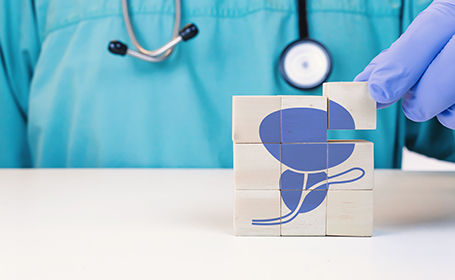
Benign Prostate Enlargement Q&A
Mr Marc Laniado is one of our leading consultant urologists at The Princess Margaret Hospital. He offers a comprehensive view of benign prostate enlargement, including its risks, treatment options and the lifestyle changes you can make to prevent it
What is benign prostate enlargement (BPE)?
In this condition the prostate becomes bigger, disturbing the urinary flow. Benign prostate enlargement is non-cancerous but it is still very significant because disturbance in urinary symptoms interferes with living a normal life, it can be painful, and sometimes it can cause serious ill-health. By the age of 50, about three in 10 men will have it, and by 70 years almost eight in 10 men will be suffering with BPE.
BPE is also known as benign prostatic hyperplasia and abbreviated to BPH.
What are the symptoms of an enlarged prostate and how is it diagnosed?
Initially, men may notice they pass urine more frequently and at night than their peers. They may also notice that it takes a while to get started when reaching the toilet and the flow is less strong.
These symptoms may deteriorate over time such that the urinary flow stops and starts, and that it takes a long time to finish passing urine. If a urine infection occurs, then these symptoms become exacerbated, it hurts to pass urine, the urine smells foul and blood may be seen in the urine.
Some men suddenly become unable to pass urine at all. This is very painful and will make a man go to the accident & emergency department even if he did not want to visit a doctor before!
What causes BPE?
As with all things in medicine, the causes of BPE are incompletely understood.
Age is the most important factor. Up to 40% of men aged 50 may have evidence of BPE, and this increases further with age.
Studies on twins and families of men with BPH have shown a family history is important, especially if BPE occurs under 60 years of age. For men with relatives who require surgery for BPE, the risk for BPE-related surgery was increased four-fold.
Black men are more likely than white men to have BPE, whereas Asian men are less likely to develop the condition. Benign prostate enlargement is also associated with heart disease, use of drugs known as beta-blockers, and lack of physical exercise.
Fat appears to be important as it induces inflammation, which in turns causes BPE. BPH is more common in obese men, and certain dietary fats may induce inflammation. Prostatitis, which is inflammation of the prostate, is associated with an enlarged prostate and BPE.
There is no causal relationship between BPE and cancer

Can a benign enlarged prostate lead to cancer?
There is no causal relationship between BPE and cancer, although it has been speculated that there might be. In men with BPE, the prostate becomes enlarged and a marker called PSA in the blood becomes elevated. This is because the level of PSA is proportional to the size of the prostate. PSA is also produced excessively by prostate cancer and so a high PSA can be used to identify men who may have prostate cancer. However, men with benign prostate enlargement have large prostates and so higher levels of PSA anyway.
Consequently, people with the condition get tested for prostate cancer more intensely than men without BPE who do not have their PSA elevated. When men with BPH present to doctors, the PSA test is often done and prostate cancer is consequently found when it would not have been diagnosed had the men not visited their doctors because of urinary symptoms.
How is BPE treated? What are the treatment alternatives?
There are many treatments for BPE. Which one you are recommended will depend on the amount of bother the symptoms cause and the physical configuration of the prostate.
For men with mild symptoms, changes in lifestyle may be enough to make life comfortable again. Usually, avoiding caffeine and alcohol, preventing constipation, and restricting fluid consumption before times when toilets are unavailable can be enough to improve your quality of life.
Some medications can improve symptoms by relaxing some of the muscles that tense up as BPE occurs. These drugs are known generally as alpha blockers, and include tamsulosin and alfuzosin. They improve symptoms mildly and make only a slight difference to the urinary flow rate.
Other drugs, such as finasteride or dutasteride, can shrink the prostate by around 10 to 20%, but they can take between 6 and 24 months to work. They do not alleviate urinary symptoms as much as alpha blockers, but they do reduce the chance of urinary retention and other problems due to BPH. There are side-effects such as breast enlargement and erectile dysfunction.
If tablets are not enough, then traditionally an operation called TURP was performed. After this procedure, urinary symptoms are significantly improved, but there can be sexual side-effects such as no semen ejaculated on orgasm, loss of erections and bleeding. TURP has been superseded by two new procedures that can improve urinary symptoms without affecting erections or ejaculation. Both are done as a day case either under local or general anaesthesia, and no catheter is required:
- UroLift: the prostate is pulled open and held in place by an implant containing metal tags at each end - like a 'treasury tag'
- Rezum: the prostate is vapourised in a highly selective manner without a permanent implant remaining, allowing ejaculation to occur normally without affecting erections
Both procedures improve symptoms significantly but in my experience the Rezum procedure is preferable because if you need to take MRI scans of the prostate to detect cancer, these will be of better quality. The metal implant of UroLift can impair MRI quality. Furthermore, both are not so good for men with large prostates
In men with big prostates, lasers can be used to shrink or vapourise the prostate. Holmium laser enucleation of the prostate (HoLEP) improves the urinary flow more than any other laser or procedure for BPE. It can be done as a day case or as an over-night stay with a rapid recovery. GreenLight laser is an alternative laser to the HoLEP procedure.
What are the long-term effects of BPE?
Normally, urine flows from the bladder through a channel in the prostate into the urethra in the penis and onto the outside world. As the prostate enlarges, the channel becomes compressed, and the stream becomes weaker. The bladder tries to compensate for the restriction by squeezing more strongly. Consequently, the bladder muscles become thicker, and in turn become more sensitive to even small amounts of urine. The bladder tells the brain that it needs to empty at lower and lower volumes, and so men need to pass urine more frequently and at night.
Initially, there are urinary symptoms only, but as the disease progresses, urine infections occur and bladder stones develop. Eventually, the bladder muscles stop contracting so the bladder no longer empties adequately. As urine accumulates in the bladder, the kidneys may fail or men cannot pass urine at all and go into a painful state called 'acute retention' in which a urethral catheter is required to empty the bladder.
Having a healthy diet and being physically active can help. Being overweight increases the risk of BPE, so it helps to stay slim and healthy in general.
Can you prevent BPE?
Many of the risk factors such as age or your genes cannot be changed. However, having a healthy diet and being physically active can help. Being overweight increases the risk of BPE, so it helps to stay slim and healthy in general.
Drugs such as finasteride or dutasteride can slow the growth of the prostate and prevent BPH-related complications, but do have side-effects as described above.
There are no other ways to reduce the chance of BPE.

Tags
How do I book an appointment?
If you're concerned about symptoms you're experiencing or require further information on this subject, talk to a GP or see an expert consultant at your local Circle Hospital.